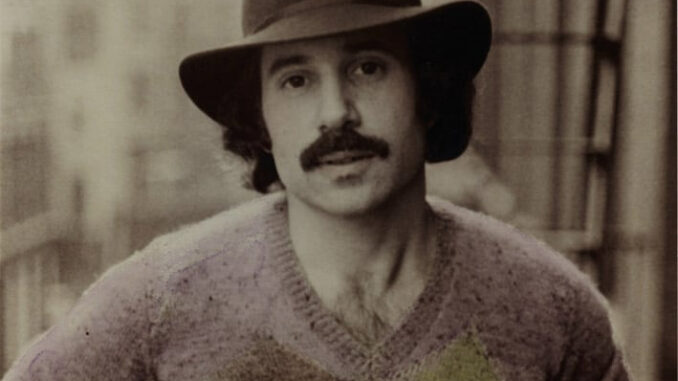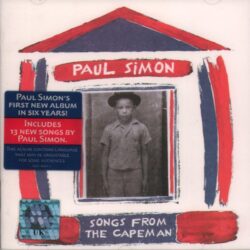
“Remember one man’s ceiling is another man’s floor.”
It may seem like Paul Simon has been around forever, and if you are of the Baby Boomer generation your perception may be right. Simon (age 83) and Dylan (83) have become the Jagger (81) and Young (79) of folk music. All four of these musicians qualified years ago for Social Security and Medicare except, of course, for Sir Mick, who would need to depend upon the NHS and the NIS if he wasn’t worth north of $500 million.
The point is: There are plenty of Paul Simon albums that have accumulated to consider for this CLWICLWI feature, and that’s not counting those 9 (5 studio, 4 live) he recorded with the immortal Art Garfunkel (83), whom he divorced in 1970. And speaking of divorces, shouldn’t we consider ranking wives as well? Let’s put a pin in that for now.
Simon’s discography contains 19 albums (15 studio and 4 live), and for our purposes we’ll eliminate the live sets from consideration. The 15 are, in chronological order: “The Paul Simon Songbook” (CBS, 1965), “Paul Simon” (Columbia, 1972), ”There Goes Rhymin’ Simon” (Columbia, 1973), “Still Crazy After All These Years” (Columbia, 1975), “One-Trick Pony” (Warner Brothers, 1980), “Hearts and Bones” (Warner Brothers, 1983), “Graceland” (Warner Brothers, 1986), “The Rhythm of the Saints” (Warner Brothers, 1990), “Songs from the Capeman” (Warner Brothers, 1997), “You’re the One” (Warner Brothers, 2000), “Surprise” (Warner Brothers, 2006), “So Beautiful or So What” (Hear Music, 2011), “Stranger to Stranger” (Concord, 2017), “In the Blue Light” (Legacy, 2018), & “Seven Psalms” (Owl/Legacy 2023)
That’s really not a tremendous amount of music when you take into account Dylan has 41 studio albums to his credit, Young has 43 and Jagger/Rolling Stones 36 (along with 39! live albums). But it’s more than enough to do our thing since I have listened to them all with the exception of (surprise) “Surprise“. And for that one, this handy little software program that enables you to download anything you want from YouTube provided the wav files for burning a CDR.

Simon’s output is relatively low, and that may be in part because he is meticulous in his attention to detail and craft. He also has a handful of very good songs that were never on a studio album – ‘Slip Slidin’ Away’ and ‘Stranded in a Limousine’ first appeared on 1977’s “Greatest Hits Etc.”, while ‘Thelma’ was an outtake from “The Rhythm of the Saints” that first appeared on 1993’s “Paul Simon Anthology”.
“Hearts and Bones” was the low point of his career as the album failed to chart. It was planned to be a reunion with Garfunkel, but Simon shelved that idea when his erstwhile cohort was constantly late or a no-show for recording sessions. Simon reinvented himself with “Graceland” three years later and explored world music further with “The Rhythm of the Saints”. He carried that momentum into the 21st century despite the boondoggle of “Songs from the Capeman” (album and theatre).
Can’t Live With It: “Songs from the Capeman” (Warner Brothers, 1997)
 Simon spent much of the 1990s working on a proposed Broadway musical, “The Capeman”, bucking history that showed Broadway albums rarely make the Billboard top 200, let alone making the climb anywhere near the top of the Hot 100. It was written about Salvador Agron, a Puerto Rican illegal immigrant who murdered two teenagers in Manhattan in 1959, mistaking them for rival Irish-American gang members and stabbing them to death. He was called the Capeman because of his habit of wearing a black cape with red lining to a “rumble” (street fight). He was convicted and sentenced to death at the age of sixteen.
Simon spent much of the 1990s working on a proposed Broadway musical, “The Capeman”, bucking history that showed Broadway albums rarely make the Billboard top 200, let alone making the climb anywhere near the top of the Hot 100. It was written about Salvador Agron, a Puerto Rican illegal immigrant who murdered two teenagers in Manhattan in 1959, mistaking them for rival Irish-American gang members and stabbing them to death. He was called the Capeman because of his habit of wearing a black cape with red lining to a “rumble” (street fight). He was convicted and sentenced to death at the age of sixteen.
Simon reportedly spent over a million dollars of his own money on the production, which didn’t endear him to the old Broadway theater crowd as things just weren’t done that way. Typically, a writer would submit a script and score to a director, who would line up a producer for the play. The producer puts together the funding to finance everything.
The New York Times reported the show was a “spectacular and costly flop” and was protested vehemently by the families of the victims, while the album, with Simon’s versions of songs from the musical, was his lowest-charting album. Simon doesn’t convince as a Broadway songwriter – the best songs, like ‘Trailways Bus’ and ‘Can I Forgive Him?’, adhered closest to his singer-songwriter roots. And the odd mix of Latin and doo-wop didn’t work.
Simon said he didn’t “give a shit” what the critics thought or said and was highly insulted when the overnight reviews came in. Even in liberal New York, basing your play on a horrible tragedy should have been rethought, especially since the streets were littered with gangs and violence. And to reiterate what the play quoted, if Salvador had been killed no one would have cared. The Capeman would have been a nobody, a common thug.
All this said, it’s still Paul Simon writing the songs, so there are always some you can get into. ‘Trailways Bus’ stands on its own as one that could have been placed on many of Simon’s other albums. Various people were travelling through Dallas and the site of the JFK assassination to Washington D.C. when the bus was stopped and boarded. “The border patrol outside of Tucson boarded the bus: “Any aliens here?” On ‘Can I Forgive Him?’ Simon wisely limits the tender ballad’s instrumentation to just his acoustic guitar in this tale of heartbroken mothers: One makes a plea for understanding and forgiveness while two other mothers find their grief and suffering won’t allow forgiveness into their hearts.
Unfortunately, there are more clunkers than winners and the meandering ‘Time Is An Ocean’, sung on the album by two of the play’s stars, Marc Anthony and Ruben Blades, is a total bore. Simon’s use of the Johnny Cash boom-chicka-boom sound on ‘Virgil’, the bigoted prison guard, feels like something he added because he was stumped on how to finish the song. His efforts for Latin authenticity fail miserably, way too rigid on the song about being homesick, ‘Sunday Afternoon’.
Can’t Live Without It: ”There Goes Rhymin’ Simon” (Columbia, 1973)
 This was a toss-up between “There Goes Rhymin’ Simon” and the jazzy soft rock of “Still Crazy After All These Years,” featuring the late great Michael Brecker on saxophone. Songs like ’50 Ways To Leave Your Lover’, ‘Gone At Last’, ‘My Little Town’, and the title track make Still Crazy nearly impossible not to consider. Take away the outstanding singles, however, and most of the rest are fairly unremarkable songs that deal with Simon’s divorce from Peggy Harper.
This was a toss-up between “There Goes Rhymin’ Simon” and the jazzy soft rock of “Still Crazy After All These Years,” featuring the late great Michael Brecker on saxophone. Songs like ’50 Ways To Leave Your Lover’, ‘Gone At Last’, ‘My Little Town’, and the title track make Still Crazy nearly impossible not to consider. Take away the outstanding singles, however, and most of the rest are fairly unremarkable songs that deal with Simon’s divorce from Peggy Harper.
“There Goes Rhymin’ Simon” is eclectic and jam-packed from start to finish with highlights. And being recorded in Muscle Shoals, Alabama with the studio band certainly didn’t hurt. Legend has it that Simon only sought out the studio because he liked what he heard on a track cut there by the Staple Singers, ‘I’ll Take You There’, and showed up expecting to find a group of Jamaican musicians. Surprised to find a largely white crew, he rolled tape on what he thought would be one song: ‘Take Me to the Mardi Gras’.
“We cut it on one take,” bass player David Hood recalled. “He’s got all this time left over, and he’s not going to pay four days’ worth of studio time for one song. So, he says, ‘What else can we record?’ He couldn’t believe we were able to get it down so quickly because he always needed many takes. But we had our thing down to a science.”
The band’s loose feel gave the album its reflective sensitivity that was balanced by a sunny impishness and irresistible warmth. You know this set of songs and its nimble explorations of gospel, folk, and Dixieland are classics when you realize the lyrics are as pertinent today as when they were first published more than 50 years ago.
“When I look back on all the crap I learned in high school / it’s a wonder I can think at all / and though my lack of education hasn’t hurt me none / I can read the writing on the wall”. is one of the most evocative lyric passages ever. ‘Kodachrome’ is an appreciation of the things that colour our world – “Gives us the nice bright colors / gives us the greens of summers / makes you think all the world is a sunny day”.
‘Love Me Like a Rock’ was the third song recorded at Muscle Shoals. The Dixie Hummingbirds were brought in to sing harmony vocals and ended up going on tour with Simon. “She rocks me like the rock of ages” is him singing about his mother’s love, but the inspiration came from a combination of the Christian hymn ‘Rock of Ages’ and the Hebrew poem ‘Ma’oz Tzur,’ traditionally sung during Hanukkah.
The happy sad ‘Take Me to the Mardi Gras’ captures the wistful spirit that lurks under every party, never mind how outrageous the revelry at Mardi Gras. “Take your burdens to the Mardi Gras / Let the music wash your soul”. There’s a great Elton John-style piano riff on ‘One Man’s Ceiling Is Another Man’s Floor’. And the promise of America as a melting pot is the thought behind the anti-Richard Nixon harangue, ‘American Tune’. This song is notable for being based on a melody line from Johann Sebastian Bach’s chorale from “St. Matthew Passion”, itself a reworking of an earlier secular song, ‘Mein Gmüth ist mir verwirret’, composed by Hans Hassler.
Simon gets a glimpse of fatherhood in the lullaby of ‘St. Judy’s Comet’, pure happiness in ‘Was a Sunny Day’, and an important lesson in the mournful ballad, ‘Learn How to Fall.‘. “You got to drift in the breeze / Before you set your sails”. ‘Tenderness’ is pure bliss with a bite. “Honesty, it’s such a waste of energy / No, you don’t have to lie to me / just give me some tenderness beneath your honesty”.
The centrepiece of the album for this listener, at any rate,, is ‘Something So Right’, in which you have to believe Simon is making an impassioned statement about his own marriages and love affairs through the bittersweet lyrics. “When something goes wrong / I’m the first to admit it / But the last one to know / When something goes right / Oh, it’s likely to lose me / It’s such an unusual sight / Oh, I can’t, I can’t get used to something so right”. He was on the verge of divorce at the time and a tryst with actress Shelley Duvall put him over the edge. That he married singer-songwriter Edie Brickell, with whom he has remained for thirty years while fathering three children is proof that Simon finally found something so right.
*** If you are buying a CD, get the Sony remaster as the original CD transfer is flat and has a ton of surface noise. Remastered, the songs pop from the stereo even better than they did on vinyl.



Did you see Paul Simon on the 50th anniversary of SNL? He sounded much better than Sir Paul, IMHO, and his duet with Sabrina Carpenter on “Homeward Bound” was lovely. See https://youtu.be/ScFh0zNE0aE